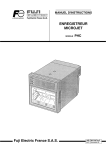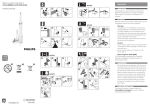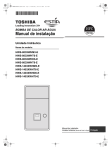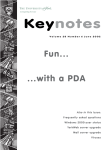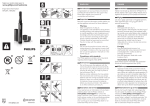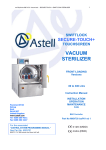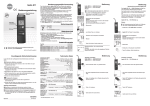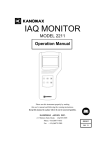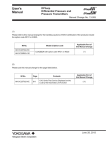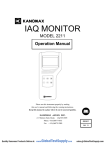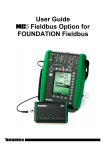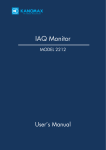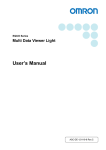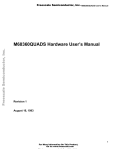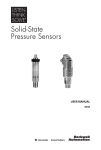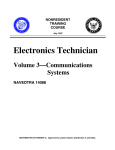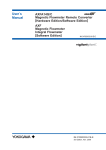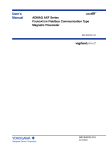Download User`s Manual
Transcript
User’s Manual Model MLX Loop Powered Process Indicator IM 60A02S01-01E-A IM 60A02S01-01E-A 2nd Edition Page 2 of 28 Contents Loop Powered Process Indicator ............................................................................................ 1 Contents .......................................................................................................................................................... 2 1. Introduction ............................................................................................................................................... 3 ■ Regarding This Manual ........................................................................................................ 3 1.1 Safe Use of This Product ........................................................................................................ 4 1.2 Warranty............................................................................................................................... 5 2. Handling Cautions ..................................................................................................................................... 6 2.1 Model and Specifications Check ............................................................................................. 7 2.2 Unpacking ............................................................................................................................. 7 2.3 Storage .................................................................................................................................. 7 2.4 Selecting the Installation Location .......................................................................................... 7 2.5 Insulation Resistance and Dielectric Strength Test.................................................................. 8 2.6 Installation of an Explosion-Protected Instrument .................................................................. 9 2.6.1 Factory Mutual (FM) Certification .................................................................................. 9 2.7 EMC Conformity Standards............................................................................................. 10 3. Installation .............................................................................................................................................. 11 3.1 Mounting Examples ............................................................................................................. 12 4. Wiring ....................................................................................................................................................... 13 4.1 Wiring Precautions .............................................................................................................. 13 4.2 Selecting the Wiring Materials ............................................................................................. 13 4.3 Wiring ................................................................................................................................. 13 4.3.1 Loop Configuration ....................................................................................................... 13 5. Operation ..................................................................................................Error! Bookmark not defined. 5.1 Overview ................................................................................Error! Bookmark not defined. 6. Maintenance ............................................................................................................................................. 22 6.1 Overview ............................................................................................................................. 22 6.2 Calibration Instruments Selection ........................................................................................ 22 6.3 Calibration .......................................................................................................................... 22 6.4 Rotating Display Direction ................................................................................................... 23 6.5 Cleaning .............................................................................................................................. 23 7. General Specifications ............................................................................................................................. 24 7.1 Standard Specifications........................................................................................................ 24 7.2 Model and Suffix Codes ....................................................................................................... 25 7.5 Dimensions .......................................................................................................................... 27 Revision Record ........................................................................................................................................... 28 IM 60A02S01-01E-A Page 3 of 28 1. Introduction Thank you for purchasing the Model MLX Loop Powered Process Indicator. Your Model MLX Process Indicator was precisely calibrated at the factory before shipment. To ensure both safety and efficiency, please read this manual carefully before you operate the instrument. The Model MLX field mounted indicator receives DC current signals from electronic transmitters and indicates process measurement values. This instruction manual gives instructions on handling, mounting, and wiring of the indicator. ■ Regarding This Manual • This manual should be provided to the end user. • The contents of this manual are subject to change without prior notice. • All rights reserved. No part of this manual may be reproduced in any form without Yokogawa’s written permission. • Yokogawa makes no warranty of any kind with regard to this manual, including, but not limited to, implied warranty of merchantability and fitness for a particular purpose. • If any question arises or errors are found, or if any information is missing from this manual, please inform the nearest Yokogawa sales office. • The specifications covered by this manual are limited to those for the standard type under the specified model number break-down and do not cover custom-made instruments. • Please note that changes in the specifications, construction, or component parts of the instrument may not immediately be reflected in this manual at the time of change, provided that postponement of revisions will not cause difficulty to the user from a functional or performance standpoint. • Yokogawa assumes no responsibilities for this product except as stated in the warranty. • If the customer or any third party is harmed by the use of this product, Yokogawa assumes no responsibility for any such harm owing to any defects in the product which were not predictable, or for any indirect damages. • The following safety symbols are used in this manual: WARNING Indicates a potentially hazardous situation which, if not avoided, could result in death or serious injury. IM 60A02S01-01E-A Page 4 of 28 CAUTION Indicates a potentially hazardous situation which, if not avoided, may result in minor or moderate injury. It may also be used to alert against unsafe practices. IMPORTANT Indicates that operating the hardware or software in this manner may damage it or lead to system failure. NOTE Draws attention to information essential for understanding the operation and features. 1.1 Safe Use of This Product For the safety of the operator and to protect the instrument and the system, please be sure to follow this manual’s safety instructions when handling this instrument. If these instructions are not heeded, the protection provided by this instrument may be impaired. In this case, Yokogawa cannot guarantee that the instrument can be safely operated. Please pay special attention to the following points: (a) Installation • This instrument may only be installed by an engineer or technician who has an expert knowledge of this device. Operators are not allowed to carry out installation unless they meet this condition. • All installation shall comply with local installation requirements and the local electrical code. (b) Wiring • The instrument must be installed by an engineer or technician who has an expert knowledge of this instrument. Operators are not permitted to carry out wiring unless they meet this condition. • Before connecting the power cables, please confirm that there is no current flowing through the cables and that the power supply to the instrument is switched off. (c) Operation • Do not open the covers when an explosive atmosphere is present. (d) Maintenance • Please carry out only the maintenance procedures described in this manual. If you require further assistance, please contact the nearest Yokogawa office. • Care should be taken to prevent the build up of dust or other materials on the display glass and the name plate. (e) Modification IM 60A02S01-01E-A Page 5 of 28 • Yokogawa will not be liable for malfunctions or damage resulting from any modification made to this instrument by the customer. 1.2 Warranty • • • • • The warranty shall cover the period noted on the quotation presented to the purchaser at the time of purchase. Problems occurring during the warranty period shall basically be repaired free of charge. If any problems are experienced with this instrument, the customer should contact the Yokogawa representative from which this instrument was purchased or the nearest Yokogawa office. If a problem arises with this instrument, please inform us of the nature of the problem and the circumstances under which it developed, including the model specification and serial number. Any diagrams, data and other information you can include in your communication will also be helpful. The party responsible for the cost of fixing the problem shall be determined by Yokogawa following an investigation conducted by Yokogawa. The purchaser shall bear the responsibility for repair costs, even during the warranty period, if the malfunction is due to: − Improper and/or inadequate maintenance by the purchaser. − Malfunction or damage due to a failure to handle, use, or store the instrument in accordance with the design specifications. − Use of the product in question in a location not conforming to the standards specified by Yokogawa, or due to improper maintenance of the installation location. − Failure or damage due to modification or repair by any party except Yokogawa or an approved representative of Yokogawa. − Malfunction or damage from improper relocation of the product in question after delivery. − Reason of force majeure such as fires, earthquakes, storms/floods, thunder/lightening, or other natural disasters, or disturbances, riots, warfare, or radioactive contamination. IM 60A02S01-01E-A Page 6 of 28 2. Handling Cautions This chapter provides important information on how to handle the MLX Loop Powered Process Indicator. Read this carefully before using the indicator. The MLX indicator is thoroughly tested at the factory before shipment. When taking delivery of an instrument, visually check it to make sure that no damage occurred during shipment. Also check that the indicator mounting hardware shown in figure 2.1 is included. After checking the indicator, carefully repack it in its box and keep it there until you are ready to install it. Figure 2.1 MLX Mounting Hardware IM 60A02S01-01E-A Page 7 of 28 2.1 Model and Specifications Check The model name and specifications are written on the name plate attached to the case. MODEL: Specified model code. SUFFIX: Specified suffix code. MFG: Year of manufacture. NO.: Serial number. INPUT: Input signal (4-20mA). CALIB RANGE: Specified calibration range. Figure 2.2 MLX Name Plate 2.2 Unpacking Keep the indicator in its original packaging to prevent it from being damaged during shipment. Do not unpack the indicator until it reaches the installation site. 2.3 Storage The following precautions must be observed when storing the instrument, especially for a long period. (a) Select a storage area which meets the following conditions: • It is not exposed to rain or subject to water seepage/leaks. • Vibration and shock are kept to a minimum. • It has an ambient temperature and relative humidity within the following ranges. Ambient temperature: –40 to 85°C (approval codes may affect limits) Relative humidity: 0% to 100% R.H. Preferred temperature and humidity: approx. 25°C and 65% R.H. (b) When storing the indicator, repack it carefully in the packaging that it was originally shipped with. 2.4 Selecting the Installation Location (1) The MLX is designed to withstand severe environmental conditions. However, to ensure that it will provide years of stable and accurate performance, take the following precautions when selecting the installation location. (2) Ambient Temperature IM 60A02S01-01E-A Page 8 of 28 (3) Avoid locations subject to wide temperature variations or a significant temperature gradient. If the location is exposed to radiant heat from plant equipment, provide adequate thermal insulation and/or ventilation. (4) Ambient Atmosphere (5) Do not install the indicator in a corrosive atmosphere. If this cannot be avoided, there must be adequate ventilation as well as measures to prevent the leaking of rain water and the presence of standing water in the conduits. (6) Shock and Vibration (7) Although the MLX is designed to be relatively resistant to shock and vibration, an installation site should be selected where this is kept to a minimum. 2.5 Insulation Resistance and Dielectric Strength Test Since the MLX has undergone insulation resistance and dielectric strength tests at the factory before shipment, normally these tests are not required. If the need arises to conduct these tests, heed the following: (1) Do not perform such tests more frequently than is absolutely necessary. Even test voltages that do not cause visible damage to the insulation may degrade the insulation and reduce safety margins. (2) Never apply a voltage exceeding 500 V DC (100 V DC with an internal lightning protector) for the insulation resistance test, nor a voltage exceeding 500 V AC (100 V AC with an internal lightning protector) for the dielectric strength test. (3) Before conducting these tests, disconnect all signal lines from the transmitter terminals. The procedure for conducting these tests is as follows: • Insulation Resistance Test (1) Short-circuit the + and – SUPPLY terminals in the terminal box. (2) Turn OFF the insulation tester. Then connect the insulation tester plus (+) lead wire to the shorted SUPPLY terminals and the minus (–) lead wire to the grounding terminal. (3) Turn ON the insulation tester power and measure the insulation resistance. The voltage should be applied as briefly as possible to verify that the insulation resistance is at least 20 MΩ. (4) After completing the test and being very careful not to touch exposed conductors disconnect the insulation tester and connect a 100 kΩ resistor between the grounding terminal and the short-circuiting SUPPLY terminals. Leave this resistor connected at least one second to discharge any static potential. Do not touch the terminals while it is discharging. • Dielectric Strength Test (1) Short-circuit the + and – SUPPLY terminals in the terminal box. (2) Turn OFF the dielectric strength tester. Then connect the tester between the shorted SUPPLY terminals and the grounding terminal. Be sure to connect the grounding lead of the dielectric strength tester to the ground terminal. (3) Set the current limit on the dielectric strength tester to 10mA, then turn ON the power and gradually increase the test voltage from ‘0’ to the specified voltage. (4) When the specified voltage is reached, hold it for one minute. (5) After completing this test, slowly decrease the voltage to avoid any voltage surges. IM 60A02S01-01E-A Page 9 of 28 2.6 Installation of an Explosion-Protected Instrument WARNING If a customer makes a repair or modification and the instrument is not restored to its original condition, its safety may be compromised and the instrument may be hazardous to operate. Please contact Yokogawa before making any repair or modification to an instrument. CAUTION This instrument has been tested and certified as being Explosionproof. Please note that severe restrictions apply to this instrument’s construction, installation, external wiring, maintenance and repair. A failure to abide by these restrictions could make the instrument a hazard to operate. WARNING Maintaining the safety of Explosionproof equipment requires great care during mounting, wiring, and piping. Safety requirements also place restrictions on maintenance and repair. Please read the following sections very carefully. 2.6.1 Factory Mutual (FM) Certification 1) Technical Data a. FM Explosionproof Type Caution for FM Explosionproof type. Note 1. Model MLX Loop Process Indicator with optional code /FF1 for potentially explosive atmospheres: • • • • • • • Certificate No. 4000798 Applicable Standard: FM 3600, FM 3615, FM 3810, NEMA 250 Explosionproof for Class I, Division 1, Groups A, B, C, and D. Dust-ignitionproof for Class II/III, Division 1, Groups E, F and G. Enclosure rating: NEMA 4X. Temperature Class: T5 Ambient Temperature: –30 to 60°C Note 2. Wiring • All wiring shall comply with National Electrical Code ANSI/NEPA70 and Local Electrical Codes. • “FACTORY SEALED, CONDUIT SEAL NOT REQUIRED”. IM 60A02S01-01E-A Page 10 of 28 Note 3. Installation • Strictly observe the “WARNING” on the attached nameplate. WARNING: OPEN CIRCUIT BEFORE REMOVING COVER. “FACTORY SEALED, CONDUIT SEAL NOT REQUIRED”. INSTALL IN ACCORDANCE WITH THE INSTRUCTION MANUAL. Note 4. Maintenance and Repair • The instrument modification or parts replacement by other than authorized representative of Yokogawa Electric Corporation is prohibited and will void Factory Mutual Explosionproof Approval. Note 5. Special Conditions for Safe Use • In the case where the enclosure of the MLX is made of aluminum, it must be installed such, that, even in the event of rare incidents, ignition sources due to impact and friction sparks are excluded. 2.7 EMC Conformity Standards EN61326-1 Class A, Table 2 (for use in industrial locations) EN61326-2-3 IM 60A02S01-01E-A Page 11 of 28 3. Installation The MLX can be mounted on a wall or a 2” pipe. The housing is NEMA 4X rated so it can be mounted outside in the field. "0 Ring" seals MUST be carefully examined after opening to ensure that the NEMA 4X protection is maintained. Damaged seals MUST be replaced. The complete electrical circuit in the hazardous area MUST be capable of withstanding an AC test voltage of 500V RMS to earth or frame of the apparatus. Where there is a possibility of attack by aggressive substances, the MLX must be protected by a suitable enclosure, capable of protecting it from the environment and the effects of impact, thermal or mechanical stress. Do not install the MLX in the following conditions: • • • Extreme Temperatures beyond the temperature rating of the instrument. High vibration areas above the vibration rating of the instrument. Extremely corrosive environments. Installation MUST comply with the requirements specified in FM 3600 and must be performed by suitably qualified staff only. IM 60A02S01-01E-A Page 12 of 28 3.1 Mounting Examples Figure 3.1 Mounting configurations IM 60A02S01-01E-A Page 13 of 28 4. Wiring 4.1 Wiring Precautions IMPORTANT • Lay wiring as far as possible from electrical noise sources such as large capacity transformers, motors, and power supplies. • Remove the electrical connection dust cap before wiring. • To prevent noise pickup, do not pass signal and power cables through the same ducts. • Explosion-protected instruments must be wired in accordance with specific requirements (and, in certain countries, legal regulations) in order to preserve the effectiveness of their explosionprotected features. The MLX is powered by the current output loop and does not require external power. All devices must be wired in series with the current loop. Twisted pair shielded cable is recommended. 4.2 Selecting the Wiring Materials (a) Use stranded leadwires or cables which are the same as or better than 600 V grade PVC insulated wire or its equivalent. (b) Use shielded wires in areas that are susceptible to electrical noise. (c) In areas with higher or lower ambient temperatures, use appropriate wires or cables. (d) In environment where oils, solvents, corrosive gases or liquids may be present, use wires or cables that are resistant to such substances. (e) It is recommended that crimp-on solderless terminal lugs (for 4 mm screws) with insulating sleeves be used for leadwire ends. 4.3 Wiring 4.3.1 Loop Configuration The following is a typical wiring example of the MLX connected to an EJA Pressure Transmitter. IM 60A02S01-01E-A Page 14 of 28 (1) General-use Type (Note: The EJA Transmitter below can be replaced with any 4-20mA 2 wire device. ) Figure 4.1 General-use Type wiring examples IM 60A02S01-01E-A Page 15 of 28 5. Operation 5.1 Overview The MLX is loop powered. Connect it in series with a 4-20mA loop as per Section 4 “Wiring”. Observe correct polarity as the indicator is protected against reversed connections but will not display a reading. After properly connecting the indicator to a transmitter or other 4-20mA source, the display will indicate the value of the current flowing in the loop (0-100% for the standard model or other specified engineering units can be user defined). IMPORTANT Connecting directly across a 24 V supply without a transmitter or similar device to regulate the loop current will result in damage to either the power supply or the MLX. The MLX can easily be ranged to display virtually any engineering units by properly calibrating and selecting the desired units to be displayed. The MLX uses a 4-key touchpad for operator input. Each key may have multiple functions assigned to it based a particular menu operation. These keys allow the user to access setup parameters, enter engineering units, zero and full-scale values, select display symbols and modify display functions. Figure 5.1 illustrates the keyboard. Figure 5.1 MLX 4-key Touch keypad. Each key serves to navigate the menu systems and select a particular value or function. The overall function of each key is shown in Table 5.1. Table 5.1 MLX key functions Key Function Selects the previous menu item or menu level Selects the next menu item or menu level Selects the current menu item or menu level Exits the menu item or menu level and returns the MLX to normal functions. IM 60A02S01-01E-A Page 16 of 28 MLX Menu Tree (Setup) 1. Calibrate 2. Eng units 3. Response 4. Indicators 5. Decimal pt 6. Scroll 7. Return (Calibrate) (Set Units) (Common) 1. Start Cal 2. Return 1. Common 2. Alphabetical 3. Clear Units 4. Return 1. % 2. bar 3. barg 4. degC 5. degF 6. inH20 7. kg/h 8. kNm3/h 9. m 10. m3/h 11. Nm3/h 12. t/h 13. Return (Eng Units) 1. Set Units 2. Eng unit 0 value 3. Eng unit FS value 4. Return (Response) 1. Linear 2. Sqrt 3. 3/2 4. 5/2 5. Custom 6. Return (Zero value) 1. Zero unit value 2. Return (FS value) 1. FS unit value 2. Return (Indicators) (Alphabetical) 1. Bar 2. x10 3. x100 4. x1000 5. % 6. P 7. SP 8. T 9. F 10. Sqrt 11. Return 1. Setup 2. Demo 1. % - %. 2. 1 - 1 3. A – F 4. G – L 5. M – R 6. S – Z 7. Return (Dec places) 1. 0 Dec pt 2. 1 Dec pt 3. 2 Dec pt 4. 3 Dec pt 5. Return (Scroll) 1. Auto 2. Off 3. All 4. Speed 5. Return (Speed) 1. Fast scroll 2. Medium scroll 3. Slow scroll 4. Return (Real-time) (Demo) 1. Real 2. Simulated 3. Return 1. Start Real 2. Return (Simulated) 1. Start Simulated 2. Return IM 60A02S01-01E-A Page 17 of 28 MLX Menu Tree (cont.) (Bar) From Indicators 1. Bar on 2. Bar off 3. Return (x10) 1. x10 on 2. x10 off 3. Return (x100) 1. x100 on 2. x100 off 3. Return (x1000) 1. x1000 on 2. x1000 off 3. Return (%) 1. % on 2. % off 3. Return (P) 1. P on 2. P off 3. Return (SP) 1. SP on 2. SP off 3. Return (T) 1. T on 2. T off 3. Return (F) 1. F on 2. F off 3. Return IM 60A02S01-01E-A Page 18 of 28 MLX Menu Tree (cont.) List of alphabetical engineering units (from Alphabetical) % %C %CH4 %CO %CO2 %CP %H2 %H2O %LEL %N2 %O2 %R.H. %RF %RH %RV %VH 1/min 1/s A ABS at ata atg atm BACARA bar BARA barabs bare bareG barG bbl/d bbl/h bbl/min bbl/s bbl_b/d bbl_b/h bbl_b/min bbl_b/p bbl_b/s bbl_o/d bbl_o/h bbl_o/min bbl_o/p bbl_o/s Bq/cm2 Bq/cm3 BRIX BTU/SCF c/s cal cal/kWh CC/MIN Cel CelD.P. cf/d cf/h cf/min cf/p cf/s CFM cft/min cm cm/min cm/s cm2 cm3 cm3/d cm3/h cm3/min cm3/p cm3/s cmAq cmAqabs cmAqG cmH2O cmH2Oabs cmH2OG cmHg cmHgabs CO2ppm COS cP cpm cps cSt d D.P. dB deg degF degR degree DEWPOINT dm2 ELm F FNU foot foot/p foot/s footAq footAqabs footH2O footH2Oabs ftH2O ftH2Oabs g g/cm2 g/cm2G g/cm3 g/d g/h g/l g/m2 g/m3 g/min g/ml g/mm2 g/mm2G g/Nm3 g/p g/s G/T gal/d gal/h gal/min gal/p gal/s GBq Gcal/h gf gf.m gf/cm2 GHz GJ GJ/h GOhm GPM gpm GW GW.h h H2% HL/H hPa hPaabs hPaG Hz in in/s inAq inAqabs inAqG inH2O inH2Oabs inH2OG inHg inHgabs inWC inWCabs inWG inWGabs J K kA kbbl/d kbbl/h kbbl/min kbbl/s kbbl_b/d kbbl_b/h kbbl_b/min kbbl_b/p kbbl_b/s kbbl_o/d kbbl_o/h kbbl_o/min kbbl_o/p kbbl_o/s KC/NM3 kcal kcal/Nm3 kcf/d kcf/h kcf/min kcf/p kcf/s kg kg/cm2 kg/cm2abs kg/cm2G kg/d kg/h kg/l kg/m2 kg/m2G kg/m3 kg/min kg/mm2 kg/mm2G kg/p kg/s kgal/d kgal/h kgal/min kgal/p kgal/s kgf kgf.m kgf/cm2 kgf/cm2abs kgf/cm2G kgf/m2 kgf/m2G kgf/mm2 kgf/mm2G kgfm kHz kJ kl kl/d kl/h kl/min kl/p kl/s klb/d klb/h klb/min klb/p klb/s KLEENH klx km km/h km3 km3/d km3/h km3/min km3/s IM 60A02S01-01E-A Page 19 of 28 km3N/h KMHO kN kN.m kN/m2 kN/m2abs kN/m2G kNm3/h knot kOhm kPa kPaabs kPaG kt kt/h kV kvar kW kW.h kW.m-2 kW/m2 KWH/M3 l L.E.L. l/d l/h l/min l/p l/s lb lb/cf lb/d lb/gal lb/h lb/in2 lb/min lb/p lb/s lbf/in2 lbf/in2abs lbw/in2 lx m m/h M/H2 m/min m/p m/s m/s2 m2 m3 m3/d m3/h m3/min m3/p m3/s m3N/h mA mAq mAqabs mAqG mb mbar mbarabs mbare mbareG mbarG mbbl/d mbbl/h mbbl/min mbbl/s mbbl_b/d mbbl_b/h mbbl_b/min mbbl_b/p mbbl_b/s mbbl_o/d mbbl_o/h mbbl_o/min mbbl_o/p mbbl_o/s mBq mcf/d mcf/h mcf/min mcf/p mcf/s mF Mg mg mg/cm2 mg/l MG/LO2 MG/LT mg/m3 mg/Nm3 Mgal/d mgal/d Mgal/h mgal/h Mgal/min mgal/min Mgal/s mgal/s Mgal_p mgal_p mGy/h mH2O mH2Oabs mH2OG mHg mHgabs MHO MHO/CM MHz micron min min-1 MJ mJ MJ.m-2 MJ/m2 MJ/Nm3 mK ml Ml/d Ml/h ml/h Ml/min ml/min Ml/p Ml/s ml/s MLB/H mm mm/h mm/min mm/s mm2 mm3 mmAq mmAqabs mmAqG MMAT MMCE mmH2O mmH2Oabs mmH2OG mmHg mmHgabs MMHO mmol/l mmP-P MMSCFD mmWC mmWCabs mmWG mmWGabs MN mN mN.m MN/m2 MN/m2G MNGF MOhm mOhm MOhm.cm MOhm/cm mol MOLWT MPa mPa mPa.s MPaabs mPaabs MPaG mPaG MPM mR/h mS ms mS/cm mS/m MSCFD MSI/CM mSv/h Mt/h MV mV Mvar MW mW MW.h MW/m2 mWC mWG N N.m N/m2 N/m2abs N/m2G N2ppm nA nF nGy/h Nkm3/d Nkm3/h Nl/h Nl/min Nl/s Nm3/d Nm3/h Nm3/min Nm3/s ns nSv/h NTU Ohm Ohm.cm Ohm-1 OPm P Pa pA Paabs PaG pF pF/m pH ppb PPHM ppm ppmCO ppmCO2 ppmH2S ppmN2 ppmNOX ppmO2 ppmSO2 psi psia psiabs psig R.M゚ R/h R/min rad rpm rps S s S.G. s-1 SCFH SCFM Sm3/h St Sv/h t t/d IM 60A02S01-01E-A Page 20 of 28 t/h t/min t/p t/s TF THz TM Torr TPm TR/min uA ubbl/d ubbl/h ubbl/min ubbl/s ubbl_b/d ubbl_b/h ubbl_b/min ubbl_b/p ubbl_b/s ubbl_o/d ubbl_o/h ubbl_o/min ubbl_o/p ubbl_o/s uF ug ug/l ug/m3 uGy/h uHg um UMHO UMHO/CM umP-P uOhm uPa uS us uS/cm uS/m USI/CM uSv/h uV uW/cm2 V VAC var vol% vol%O2 volpct W W.h W.s W/m2 wt% wtpct wtpctS wtppb wtppm X10L 5.2 Setting Engineering Units The standard configuration of the MLX sets the engineering units to 0-100%. Also, after calibration, the MLX will be set to 0-100%. (Refer to the Maintenance section for instructions on calibrating the MLX.) If other engineering units are desired, they must be setup. The following procedure illustrates an example of using units of 200-400 m3/h. (a) Touch the “Menu” button to enter the menu system. The alphanumeric display reads “Setup”. to begin the setup routine. (b) Touch The alphanumeric display reads “Calibrate”. (c) Touch to advance to the next menu item. The alphanumeric display reads “Eng units”. (d) Touch to select the Eng units routine. The alphanumeric display reads “Units”. (e) Touch to select the Units routine. The alphanumeric display reads “Alphabetical”. The choices here are: 1. Alphabetical – Use to select units from an alphabetical list 2. Units of Measure – Use to select units by specifying the units of measure (i.e, volume, time, etc.) 3. Common units – Use to select units from a common set of units 4. Custom – Allows a custom unit to be specified Touch to select alphabetical or to select another desired method. In this example, we will use Common units. to display the Units of Measure routine. (f) Touch IM 60A02S01-01E-A Page 21 of 28 (g) (h) (i) (j) The alphanumeric display reads “Units of Measure”. to display the Common units routine. Touch The alphanumeric display reads “Common units”. Touch to select the Common units routine. to scroll forward through the units (or to scroll backwards). Touch 3 When the desired unit is shown (in this case, m /h), touch to select the unit. The alphanumeric display shows “Eng units 0 value”. The numeric display shows the current engineering unit zero value with the least significant digit blinking. At this point, the menu buttons are redefined as in Table 5.2. Table 5.2 MLX key functions (when in Engineering units mode) Key Function Selects the digit to modify (digits advance from least significant to most significant to the sign symbol and back to least significant – 6 digits plus sign). Increments the selected digit (values roll over from 9 to 0). Decrements the selected digit (values roll over from 0 to 9). Accepts the modified value as the current engineering unit zero or full-scale (FS) value. (k) Touch to increment the least significant digit to the desired valued (the digits roll over from 9 to 0). (l) Touch to move to the next digit. to increment the selected (blinking) digit to the desired valued. (m) Touch (n) Repeat Steps (l) and (m) until desired value is indicated (including sign value). (o) Touch to accept the entered value as the engineering units zero value. The alphanumeric display shows “Eng units 0 value”. The numeric display shows the current engineering unit zero value. to move to the next menu item. (p) Touch The alphanumeric display reads “Eng units FS value”. The numeric display shows the current engineering unit FS value with the least significant digit blinking. (q) Repeat Steps (k) through (o) set the engineering units FS value. (r) Touch to exit the setup routine and resume measurements. IM 60A02S01-01E-A Page 22 of 28 6. Maintenance 6.1 Overview The electronics of the MLX is maintenance free. This chapter describes the procedures for calibration and rotating the display within the enclosure. Please carefully and thoroughly read the following sections for information on how to perform these maintenance procedures. 6.2 Calibration Instruments Selection Table 6.1 lists the instruments that can be used to calibrate the MLX. When selecting an instrument, consider the required accuracy level. Exercise care when handling these instruments to ensure they maintain the specified accuracy. 6.3 Calibration The MLX is factory calibrated to 0-100%. Products ordered with the /ENG Engineering Units option other than 0-100% use 0-100% as the basis for the desired engineering units. Use the procedure below to check instrument operation and accuracy during periodic maintenance or troubleshooting. (2) Connect the instruments as shown in Figure 6.1 (red wire to + OUT on current source, black wire to - OUT on current source) and warm up the instruments for at least five minutes. Table 6.1 Instruments Required for Calibration Name Yokogawa-recommended Instrument Current Standard Model CA11 Voltage/Current Calibrator or Model CA71 Multifunction Calibrator Current Source Remarks 4-20mA source MLX Loop Indicator + (Out) + (Red) - (Out) - (Black) Figure 6.1 Calibrating the MLX IM 60A02S01-01E-A Page 23 of 28 (3) Using the values in Table 6.2, check the MLX readings by setting the current source to each of the table values. Check all points in the table and verify unit is within specification. Table 6.2 Percent vs. Current Values Value 0% 25% 50% 75% 100% Current 4.0mA 8.0mA 12mA 16mA 20mA (4) If a re-calibration is required, use the following method: (a) Touch the “Menu” button to enter the menu system. The alphanumeric display reads “Setup”. to begin the setup routine. (b) Touch The alphanumeric display reads “Calibrate”. (c) Touch to begin the calibrate routine. Follow the instructions given on the display. For each calibration point, after adjusting the current standard to the value indicated, press the “Menu” button. 6.4 Rotating Display Direction The MLX display is designed so that it can be rotated in increments of 90 degrees. When there is a need to change the orientation of the display, use the following procedure: (1) Remove power from the MLX. (2) Remove the glass cover from the display side. (3) Remove the two anchor nuts from the MLX module assembly. (4) Remove and rotate the display assembly to the desired orientation. (5) Re-install and tighten the two nuts on the module assembly. (6) Replace the glass cover. 6.5 Cleaning Cleaning should be restricted to wiping with a damp cloth or approved anti-static cleaner to avoid the danger of ignition due to electrostatic charges. IM 60A02S01-01E-A Page 24 of 28 7. General Specifications 7.1 Standard Specifications □FUNCTIONAL SPECIFICATIONS Input: 4-20mA DC 2-wire Voltage Drop: 3.5V at 20mA LCD Display Numerical: Six 7-segment digits Alpha-numerical: Six 14-segment characters Bar graph: 20-segment Bar graph. Symbols: P, SP, T, F, %, √, x10, x100, x1000 Configuration: User configurable for desired engineering units. Method: User configurable from front panel Zero & Span: Zero and span can be set between ±999999. Turn-on Time: 12 second (includes power on self-test and memory integrity check) Update Time: 1 second Isolation: Input/Output/Ground isolated to 500V DC □PERFORMANCE SPECIFICATIONS Accuracy: ± 0.05% of full scale +1 digit Operating Current: 3.6mA to 28mA Ambient Temperature: -30 to +60°C (-22 to 140°F) Ambient Humidity: 0 to 100%RH at 23°C (73°F) Ambient Temperature Effect: 0.1°C per 10°C Over range: 200mA without damage Maximum error: +0.02%, -0.03% (of full scale) Conformity (Linearity): 0.03% Hysteresis error: 0.03% Repeatability: 0.03% Vibration: 3G @ 10-150Hz Shock: 50G Explosion Protection: FM (CSA, ATEX, and IEC pending) □PHYSICAL SPECIFICATIONS Enclosure Material Housing: Low copper cast aluminum alloy with Polyurethane resin baked finish - Deep sea moss green (equivalent of Munsell 0.6GY3.1/2.0) or SUS316 cast stainless steel (ASTM CF-8M) Name plate: Black anodized aluminum or 316 SST Tag: 304 SST or 316 SST Wired tag: 304 SST or 316 SST Degrees of Protection: NEMA 4X, IP67 Mounting: Nominal 2” (50mm) pipe mount or surface. (horizontal or vertical) Weight: 1.25kg (2.70 lbs)* *: Without mounting bracket Add 0.8 kg (0.35 lbs) for mounting bracket Electrical Connection: ½ NPT female or M20 female IM 60A02S01-01E-A Page 25 of 28 7.2 Model and Suffix Codes MODEL AND SUFFIX CODES Model MLX Input signal Mounting Housing Communication Electrical Connection Optional Codes Suffix Codes ………………………………........... -A…………………………………... 1…………………………............ 2…………………………............ 1…………………………........ 2…………………………........ -1…………………. -2…………………. 0…………….. 1…………….. 2…………….. 3…………….. 4…………….. Description Loop Indicator 4 to 20mA DC 2 inch Horizontal Pipe 2 inch Vertical Pipe (or wall mount) Cast aluminum alloy SUS316 cast stainless steel and ASTM CF-8M Standard HART Communications (To be announced later) ANSI ½ NPT female, two electrical connections without blind plugs ANSI ½ NPT female, two electrical connections and a 304 SST blind plug ANSI ½ NPT female, two electrical connections and a 316 SST blind plug ISO M20 female, two electrical connections without blind plugs ISO M20 female, two electrical connections and a 316 SST blind plug / □Optional specification OPTIONAL SPECIFICATIONS (For Explosion Protected Type) Item Factory Mutual (FM) CENELEC ATEX Description FM Explosion-proof Approval Applicable Standard: FM3600, FM3615, FM3810, ANSI/NEMA 250 Explosionproof for Class I, Division 1, Groups A, B, C and D, Dust-ignitionproof for Class II/III, Division 1, Groups E, F and G, in Hazardous locations, indoors and outdoors (NEMA 4X) Temperature class: T5, Ambient Temperature: –40 to 85°C (–40 to 185°F) FM Intrinsically Safe/FM Explosion-proof/FM Non-incendive Approval (Pending) Applicable Standard: FM3600, FM3610, FM3611, FM3615, FM3810, ANSI/NEMA 250 Intrinsically Safe for Class I, Division 1, Groups A, B, C & D, Class II, Division 1, Groups E, F & G and Class III, Division 1, Class I, Zone 0, in Hazardous Locations, AEx ia IIC Non-incendive for Class I, Division 2, Groups A, B, C & D, Class II, Division. 2, Groups E, F & G, and Class III, Division 1, Class I, Zone 2, Group IIC, in Hazardous Locations Enclosure: "NEMA 4X", Temp. Class: T5, Amb. Temp.: –40 to 85°C (–40 to 185°F) Intrinsically Safe Apparatus Parameters [Groups A, B, C, D, E, F and G] Vmax=30 V, Imax=200 mA, Pmax=0.9 W, Ci=6 nF, Li=0 _H [Groups C, D, E, F and G] Vmax=30 V, Imax=200 mA, Pmax=0.9 W, Ci=10 nF, Li=0 mH ATEX Intrinsically Safe/ATEX Flameproof/Non-incendive Approval (Pending) Flameproof Applicable Standard: EN 60079-0, EN 60079-1, EN 60079-31 II 2G, 2D Ex d IIC T5 Ex tD A21 IP6X T85 Degree of protection : IP66 and IP67 Temperature class: T5, Ambient Temperature: –40 to 85°C (–40 to 185°F) Intrinsically safe Applicable Standard: EN 60079-0, EN 60079-11, EN 60079-26 II 1G, 1D Ex ia IIC T5 Degree of protection : IP66 and IP67 Temperature class: T5, Ambient Temperature: –40 to 85°C (–40 to 185°F) Entity parameters : Ui=30 V, Ii=200 mA, Pi=0.9 W, Ci=10 nF, Li=0 mH Non-incendive Applicable Standard: EN 60079-0, EN 60079-11 II 3G Ex ic IIC T5 Temperature class: T5, Ambient Temperature: –40 to 85°C (–40 to 185°F) Entity parameters : Ui=30 V, Ii=200 mA, Pi=0.9 W, Ci=10 nF, Li=0 mH Code FF1 FU1 KU21 IM 60A02S01-01E-A Page 26 of 28 Item Canadian Standards Association (CSA) Canadian Standards Association (CSA) IECEx Scheme Combination of Approvals INMETRO (Brazil) Certificate GOST (Russian) Certificate Description CSA Intrinsically Safe/CSA Explosionproof Approval (Pending) Applicable C22.2 No.25, C22.2 No.30, Standard: FM 3600, FM 3615, UL 1203, UL 50, UL 50E, C22.2 No.94, C22.2 No. 94.2 Explosionproof for Class I, Division 1, Groups A, B, C and D, Dust-ignitionproof for Class II/III, Division 1, Groups E, F and G Enclosure: TYPE 4X, Temp. Code: T5 Ex d IIC T5 Enclosure: IP66 and IP67 Amb.Temp.:–40 to 85°C(–40 to 185°F) for T5 Applicable Standard: C22.2 No.0, FM 3600, FM 3610, FMRC 3611, UL 60079-0, UL 60079-11, C22.2 No.60079.0, CAN/CSA E60079-11, C22.2 No.213, CAN/CSA C22.2 No.157 Intrinsically Safe for Class I, Division 1, Groups A, B, C & D, Class II, Division 1, Groups E, F & G, Class III, Division 1, Non-incendive for Class I, Division 2, Groups A, B, C & D, Class II, Division 2, Groups E, F & G, Class III, Division 1 Enclosure: Type 4X, Temp. Code: T5 Amb. Temp.:–40 to 85°C(–40 to 185°F) Electrical Parameters: [Intrinsically Safe] Vmax=30V, Imax=200mA, Pmax=0.9W, Ci=10nF, Li=0 [Non-incendive] Vmax=30V, Ci=10nF, Li=0 [For CSA E60079] Ex ia IIC T5, Ex ic IIC T5 Enclosure: IP66 and IP67 Amb. Temp.:–40 to 85°C(–40 to 185°F) Electrical Parameters: [Ex ia] Ui=30V, Ii=200mA, Pi=0.9W, Ci=10nF, Li=0 [Ex ic] Ui=30V, Ci=10nF, Li=0 IEC Intrinsically Safe/IEC Flameproof Approval (Pending) Intrinsically safe and type n Applicable Standard: IEC 60079-0, IEC 60079-1, IEC 60079-11, IEC 60079-26, IEC 60079-31 II 1G, 1D Ex ia IIC T5, II 3G Ex ic IIC T5 Degree of protection : IP66 and IP67 Amb. Temp.:–40 to 85C(–40 to 185F) Electrical Parameters: [Ex ia] Ui=30V, Ii=200mA, Pi=0.9W, Ci=10nF, Li=0 [Ex ic] Ui=30V,Ci=10nF, Li=0 Flameproof Applicable Standard: IEC 60079-0, IEC60079-1 II 2G, 2D Ex d IIC T5 Ex tD A21 IP6X T85 Degree of protection : IP66 and IP67 Amb.Temp.:–40 to 85°C(–40 to 185°F) for T5 Code Combination of FU1, CU1 and KU21 Approvals V1U INMETRO Intrinsically Safe/INMETRO Flameproof Approval (Pending) BU1 Russian GOST certifícate (Pending) QR1 CU1 SU2 OPTIONAL SPECIFICATIONS Item Description Code Paint Epoxy resin paint Polyurethane-Epoxy combination paint (Anti-corrosion coating) Calibration Calibration range and scale ENG Stainless steel tag plate Stainless steel tag screw attached to housing Stainless steel tag wired to housing SST SSW ORDERING INFORMATION Specify the following when ordering: 1. Model and suffix codes. 2. Option codes. 3. Tag number 4. Calibration range desired (optional) X1 X2 OPTIONS The MLX is fully field configurable from the front panel. To order a pre-configured unit, specify the /ENG option followed by the desired setpoints (zero, full scale, and engineering units). IM 60A02S01-01E-A □Example Ordering Information: MLX-A11-10/FF1/ENG/SST (Field Mounted Loop Indicator, 4 to 20mA DC, 2” Horizontal Pipe mount, aluminum housing, standard communication, ANSI ½ NPT electrical connection without blind plugs, FM Explosion-proof approval) 0-200 InH2O Scale in Engineering Units. Please specify Scale and Engineering units when ordering /ENG. FT-201 Specify Tag Number when ordering /SST and/or /SSW. 7.5 Dimensions IM 60A02S01-01E-A 2nd Edition Page 28 of 28 Revision Record Title: MLX Loop Powered Process Indicator Manual No.: IM 60A02S01-01E-A Edition 1st 2nd Date January 2012 March 2012 Page Revised Item -New publication 14, 21 Removed J12 reference; modified Specifications IM 60A02S01-01E-A





























